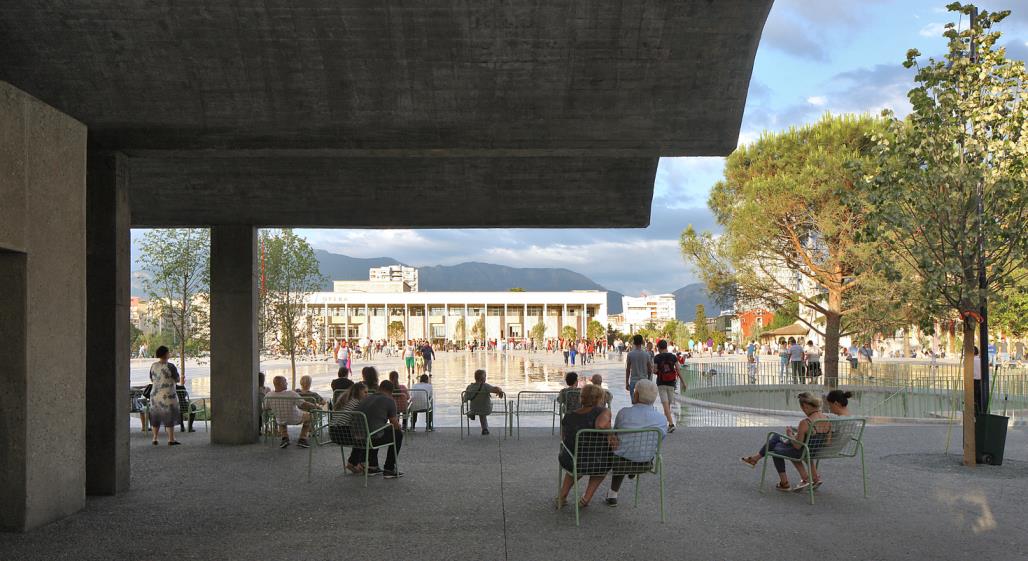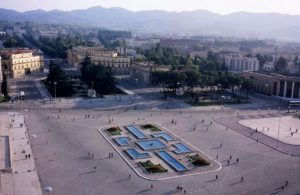Anyone who has spent much time in places that were designed by architects and engineers of the old Soviet Union tend to use three words in describing the experience: “cold,” “grey” and “sterile”. “Lifeless” is also a common descriptor.
Back in 2008, the capital city of Tirana, Albania decided to remove those characteristic from their grand, Soviet-designed public square.
The architecture firm 51N4E (why do so many architects desire company names no one can remember?) won the city’s competition to design a revitalized Skanderbeg Square. Now, we can see the results.
The winning proposal, conceived in collaboration with Albanian artist Anri Sala, reorganizes Tirana’s central square, a vast ex-communist space, in a simple yet radical way.
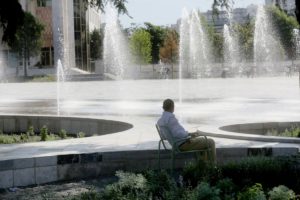 In a complex and dense urban context, on this site that is both the core of the Albanian capital city and a symbol for the whole country, the project installs a generous pedestrian area.
In a complex and dense urban context, on this site that is both the core of the Albanian capital city and a symbol for the whole country, the project installs a generous pedestrian area.
The square presents itself as a void in the chaos of the city, a flat pyramid lined by a densely planted periphery, formed by a collection of old and new public spaces and gardens. The resulting green belt acts as an antechamber negotiating the transition between the congested city and the square.
The oppressive monumentality of Communist architecture is counteracted by the ample and low pyramid making up the square: when standing at its tip, the citizens find themselves at par with the authoritarian architecture of the past. They can contemplate the buildings defining Albania’s past, suddenly opened up to new ways of reading, and embrace them as a history on which to build on.
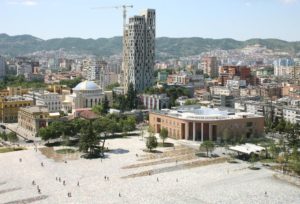 After the start of the works in 2010, and following a change in administration, the implementation of the project was abruptly halted. Yet a new election relaunched the project end of 2015. The evolution of the urban context, as well as a reevaluation of the ambitions of durability, offered an opportunity to refine the proposal while keeping the concept’s essence intact.
After the start of the works in 2010, and following a change in administration, the implementation of the project was abruptly halted. Yet a new election relaunched the project end of 2015. The evolution of the urban context, as well as a reevaluation of the ambitions of durability, offered an opportunity to refine the proposal while keeping the concept’s essence intact.
The project’s landscaping was studied anew, and turned into a local ecosystem anticipating the creation of a new urban ecology for the city. Local species were chosen to increase the system’s natural resistance by reacting to ongoing climate change.
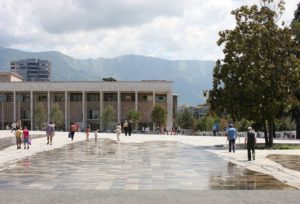 Trees, shrubs and perennials were combined to foster urban biodiversity and control the city center’s microclimate. Albania’s nature’s richness in diverse species and varieties is thus valorized, allowing public space to assume bot recreational and educative functions.
Trees, shrubs and perennials were combined to foster urban biodiversity and control the city center’s microclimate. Albania’s nature’s richness in diverse species and varieties is thus valorized, allowing public space to assume bot recreational and educative functions.
The green belt around the square is made up of 12 gardens, each of them linked to one or more of the public or private institutions lining the square.
The spatial organization of these gardens, as well as their technical aspects, were studied in dialogue with all the main actors of the project over the course of several workshops.
The result is a set of contextualized interventions, inviting public and semi-public neighboring functions to spread into the exterior space.
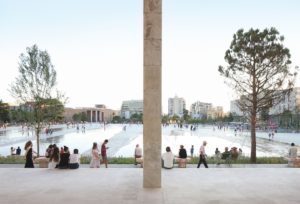 In the frame of the readjustment of the project, specific attention was given to mobility questions and investments in the immediate and broader context of the square.
In the frame of the readjustment of the project, specific attention was given to mobility questions and investments in the immediate and broader context of the square.
An underground parking garage, able to host multiple functions, was developed in collaboration with the city’s mobility services. Similarly, pedestrian and bicycle connections and links to the public transportation network were established.
Finally, local materials were preferred, both for logistic and symbolic reasons, which led to the reactivation of local stone quarries and turned the project also on this level into a revelator of the richness of the Albanian context and stimulation of its production capacity.
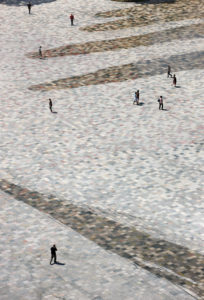 Here’s a quick history of the square: In 1917, the Austrians built a public square, where the Skanderbeg Square is located nowadays. After Tirana became the capital in 1920, and the population increased, several city plans were planned.
Here’s a quick history of the square: In 1917, the Austrians built a public square, where the Skanderbeg Square is located nowadays. After Tirana became the capital in 1920, and the population increased, several city plans were planned.
During the time of the Albanian monarchy from 1928 to 1939, the square comprises a number of buildings that would eventually be demolished during the communist period. The square contained a roundabout with a fountain in the center. The Old Bazaar used to be established on the grounds of modern-day Palace of Culture, the Orthodox Cathedral (which is now the Tirana International Hotel), while the former City Hall building, on the grounds of where the National Historical Museum is located nowadays.
A statue of Joseph Stalin was erected, where today the Skanderbeg Monument is located. Besides the construction of the above new elements during communism, the statue of Albania’s notorious leader Enver Hoxha was erected at the space between the National Historical Museum and the National Bank. Following the fall of communism in 1991, the statue would be removed amid student-led demonstrations. The square is now part of the largest pedestrian zone in the Balkans.
This 51N4E-designed renovation won the European Prize for Urban Public Space in 2018. Congratulations, folks!
All photo are by Filip Dujardin / 51N4E.

